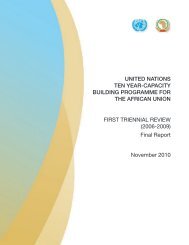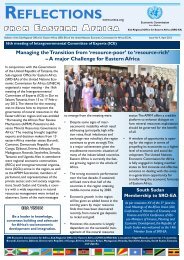A Decade of NEPAD - Economic Commission for Africa - uneca
A Decade of NEPAD - Economic Commission for Africa - uneca
A Decade of NEPAD - Economic Commission for Africa - uneca
You also want an ePaper? Increase the reach of your titles
YUMPU automatically turns print PDFs into web optimized ePapers that Google loves.
88 A <strong>Decade</strong> <strong>of</strong> <strong>NEPAD</strong>: Deepening <strong>Africa</strong>n Private Sector and Civil Society Ownership and Partnership<br />
As no single road map will suit all countries, each <strong>Africa</strong>n<br />
country is expected to implement the CAADP Agenda in<br />
its own way – although each will be able to use a common<br />
set <strong>of</strong> tools, such as the Pillar frameworks and the country<br />
roundtable processes. Success will be measured by the<br />
extent to which each country’s policies and investment<br />
programmes change are re<strong>for</strong>med as benchmarked against<br />
the common principles and goals <strong>of</strong> the CAADP Agenda.<br />
The national roundtables lead to national pacts between<br />
donors and individual governments that will help different<br />
countries to achieve the four Pillars. Each national<br />
roundtable takes responsibility <strong>for</strong>:<br />
ӹ aligning state policies with regional priorities and the<br />
four Pillars;<br />
ӹ exploiting synergies and discussing economic bottlenecks<br />
between neighbouring countries, and deciding<br />
appropriate action on those matters;<br />
ӹ identifying gaps in the donor funding needed to achieve<br />
agreed priorities;<br />
ӹ initiating work to monitor and evaluate CAADP’s progress<br />
at the national, regional and continental levels.<br />
With the four Pillars as a framework, CAADP ef<strong>for</strong>ts drill<br />
down to the national level through a roundtable process<br />
that focuses on:<br />
ӹ exploiting synergies and inclusive, evidence-based discussions<br />
on socio-economic bottlenecks and deciding<br />
appropriate action on those matters;<br />
ӹ identifying gaps in donor funding needed to achieve<br />
agreed priorities;<br />
ӹ initiating work to monitor and evaluate CAADP’s progress<br />
at the national, regional and continental levels;<br />
ӹ aligning state policies with regional priorities and the<br />
four Pillars;<br />
ӹ developing long-term commitments to finance agricultural<br />
investment programmes that are aligned with<br />
CAADP principles and targets.<br />
The country roundtable process is flexible and is being<br />
constantly adapted, becoming more robust as it is used<br />
and refined.<br />
Since CAADP’s inception, <strong>NEPAD</strong>, the Regional <strong>Economic</strong><br />
Communities (RECs) and the <strong>Africa</strong>n Union (AU), have<br />
worked together with a number <strong>of</strong> donors and <strong>Africa</strong>n<br />
governments to mobilise and harmonise support <strong>for</strong> the<br />
initiative. Collectively, they have helped to establish the<br />
CAADP Multi-donor Trust Fund which is hosted at the<br />
World Bank and funnels financial support to CAADP<br />
processes and investments.<br />
The CAADP Multi-donor Trust Fund is a flexible yet<br />
systematic, efficient and reliable way to:<br />
ӹ Allow economies <strong>of</strong> scale<br />
ӹ Complement existing resources mobilised around<br />
CAADP Pillars and other thematic priorities<br />
ӹ Facilitate partnerships and coalition building among<br />
<strong>Africa</strong>n institutions, partners and donors<br />
ӹ Harmonise priorities<br />
ӹ Increase the efficiency and effectiveness <strong>of</strong> financial<br />
resources<br />
ӹ Target specific gaps in financing, capacity and<br />
technology<br />
For potential private sector partners, consultants and/or<br />
clients, each <strong>of</strong> the four CAADP pillars <strong>of</strong>fers different<br />
prospective engagement opportunities:<br />
Pillar 1 –<br />
Sustainable Land and Water Management<br />
The lead technical agencies <strong>of</strong> Pillar 1 are the University<br />
<strong>of</strong> Zambia, and the Burkina Faso based Permanent Interstate<br />
Committee <strong>for</strong> Drought Control in the Sahel. The<br />
programme in Pillar 1 focuses on:<br />
ӹ Development <strong>of</strong> the pillar vision and framework<br />
ӹ Forging partnerships <strong>for</strong> sustainable land and water<br />
management<br />
ӹ The mobilization <strong>of</strong> US$150 million, leveraging US$1<br />
billion, and<br />
ӹ Facilitation <strong>of</strong> the CAADP country roundtables.<br />
Key initiatives under Pillar 1 to date involve the following:<br />
ӹ Terr<strong>Africa</strong>: Under Pillar 1, the Terr<strong>Africa</strong> Initiative has<br />
mobilised US$1 billion <strong>for</strong> investment in country programmes<br />
<strong>for</strong> sustainable land and water management<br />
through the Global Environment Facility (GEF) Strategic<br />
Investment Programme. Initially, GEF provided<br />
US$150 million; a further US$900 million was invested<br />
by the Initiative. The design <strong>of</strong> country programmes and<br />
disbursement <strong>of</strong> funds is already under way.<br />
ӹ Conservation agriculture: In 2008, the Norwegian Government<br />
committed US$4 million in response to the







